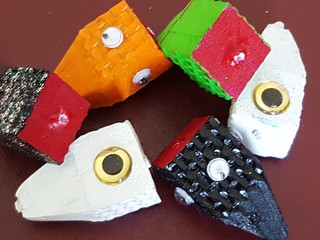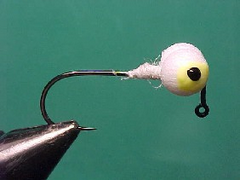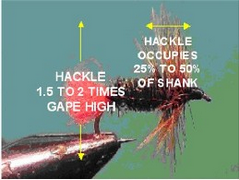Posts Tagged ‘Free fly tying’
{{start}}
{{end}}

{{+1}}Articulated popper head{{-1}}
{{start}}
Poppers are a bit harder to cast than a normal fly because of the wind resistance but if you slow your cast down a little I'm sure you'll soon get the hang of it. Once you do you have another tool in your arsenal which is useful in three diverse situations:{{end}}
{{+1}}Wet fly – hackles{{-1}}
{{start}}
Hackles and hackle fibres are used in various ways in the construction of wet flies. Whilst poorer dry fly hackle capes have traditionally been used in wet flies, over recent years, specific wet fly capes and saddles have evolved by the selective breeding of various birds.{{end}}
{{+1}}Hooks – selecting the right hook{{-1}}
{{start}}
You could spend a lot of time to understand why hooks work for particular applications. The list below is just a small splattering of the types of hooks available but has been selected so as to help develop an understand of why different types of hooks are chosen for different purposes.{{end}}
{{+1}}Segments – body segments on flies{{-1}}
{{start}}
Most of the things we seek to imitate with flies have bodies that have some sort of segmentation. A number of techniques have been developed to imitate those body segments and often also to reinforce the fly.{{end}}

{{+1}}Weight – adding weight to a fly{{-1}}
{{start}}
Adding weight to flies is almost as old as fly fishing itself. The main aim is to get flies or teams of flies down to where the fish are holding. There are many ways of adding weight to flies and this post examines many of the most common techniques.{{end}}

{{+1}}Deer hair – brush type wings{{-1}}
{{start}}
A very popular technique for tying emerger flies. More recently brushes have been tied from CDC as well as deer hair and both work well. The secret of course is that both materials float well. Deer hair brush type wings are a very effective way of adding flotation to a fly just where you want it. As long as you have the buoyancy of the wing and the weight equation of the fly correct the wing will hold the fly in the surface film with the business end right in the trouts face.{{end}}

{{+1}}Tails – divided hackle or hair{{-1}}
{{start}}
Spinner tails are typically quite long and very fine and if you incorporate those characteristics in your flies you will find that the tails look very life like when you firstt tie your fly but once the fly has been in your fly box for a while the tails get damage and broken and the fly looks ugly. I think its better to compromise on the length of the tail and to add a couple of extra hackle fibres so that your fly will stand the test of time.{{end}}

{{+1}}Tails – dahlberg diver type tails{{-1}}
{{start}}
Dahlberg Diver tails are generally equal in length to between the length of the hook shank and two times the length of the hook shank. Avoid making tails too long because sometimes the fish will hit the movement of the tail and miss the hook completely. This is often referred to as a "short take" or "taking short". Good marabou tails are a real bonus to a big dry fly because the marabou hangs in the water and has a lot of movement.{{end}}

{{+1}}Eyes – booby eyes from bean bag beads{{-1}}
{{start}}
Set out below are the tying instructions for Booby eyes made out of bean bag beads for a right handed fly tier. If your left handed please remember to switch the instructions around.{{end}}

{{+1}}Hackle – dry fly{{-1}}
{{start}}
There is a lot to hackling a dry fly than just grabbing a feather and tying it on toward the front of the fly. This post deals with some of the variable you should consider.{{end}}













